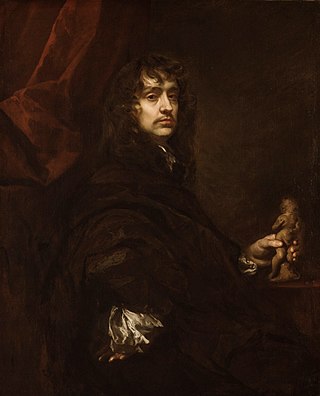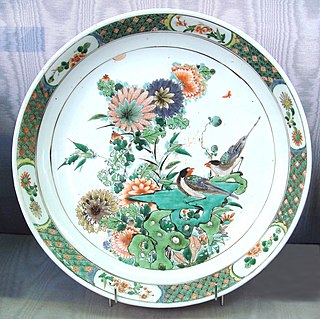
Josiah Wedgwood was an English potter, entrepreneur and abolitionist. Founding the Wedgwood company in 1759, he developed improved pottery bodies by systematic experimentation, and was the leader in the industrialisation of the manufacture of European pottery.

Spode is an English brand of pottery and homewares produced in Stoke-on-Trent, England. Spode was founded by Josiah Spode (1733–1797) in 1770, and was responsible for perfecting two important techniques that were crucial to the worldwide success of the English pottery industry in the 19th century: transfer printing on earthenware and bone china.

The Staffordshire Potteries is the industrial area encompassing the six towns Burslem, Fenton, Hanley, Longton, Tunstall and Stoke in Staffordshire, England. North Staffordshire became a centre of ceramic production in the early 17th century, due to the local availability of clay, salt, lead and coal.

Creamware is a cream-coloured refined earthenware with a lead glaze over a pale body, known in France as faïence fine, in the Netherlands as Engels porselein, and in Italy as terraglia inglese. It was created about 1750 by the potters of Staffordshire, England, who refined the materials and techniques of salt-glazed earthenware towards a finer, thinner, whiter body with a brilliant glassy lead glaze, which proved so ideal for domestic ware that it supplanted white salt-glaze wares by about 1780. It was popular until the 1840s.

Transfer printing is a method of decorating pottery or other materials using an engraved copper or steel plate from which a monochrome print on paper is taken which is then transferred by pressing onto the ceramic piece. Pottery decorated using this technique is known as transferware or transfer ware.

Wedgwood is an English fine china, porcelain and luxury accessories manufacturer that was founded on 1 May 1759 by the potter and entrepreneur Josiah Wedgwood and was first incorporated in 1895 as Josiah Wedgwood and Sons Ltd. It was rapidly successful and was soon one of the largest manufacturers of Staffordshire pottery, "a firm that has done more to spread the knowledge and enhance the reputation of British ceramic art than any other manufacturer", exporting across Europe as far as Russia, and to the Americas. It was especially successful at producing fine earthenware and stoneware that were accepted as equivalent in quality to porcelain but were considerably cheaper.

Mintons was a major company in Staffordshire pottery, "Europe's leading ceramic factory during the Victorian era", an independent business from 1793 to 1968. It was a leader in ceramic design, working in a number of different ceramic bodies, decorative techniques, and "a glorious pot-pourri of styles - Rococo shapes with Oriental motifs, Classical shapes with Medieval designs and Art Nouveau borders were among the many wonderful concoctions". As well as pottery vessels and sculptures, the firm was a leading manufacturer of tiles and other architectural ceramics, producing work for both the Houses of Parliament and United States Capitol.

Sir Peter Lely was a painter of Dutch origin whose career was nearly all spent in England, where he became the dominant portrait painter to the court. He became a naturalised British subject and was knighted in 1679.

Capodimonte porcelain is porcelain created by the Capodimonte porcelain manufactory, which operated in Naples, Italy, between 1743 and 1759. Capodimonte is the most significant factory for early Italian porcelain, the Doccia porcelain of Florence being the other main Italian factory. Capodimonte is most famous for its moulded figurines.

The Cambrian Pottery was founded in 1764 by William Coles in Swansea, Glamorganshire, Wales. In 1790, John Coles, son of the founder, went into partnership with George Haynes, who introduced new business strategies based on the ideas of Josiah Wedgwood. Lewis Weston Dillwyn became a partner in 1802 and sole owner when George Haynes left the pottery in 1810. In 1811 Dillwyn took T.& J. Bevington into partnership, the company becoming known as Dillwyn & Co.

The Imperial Porcelain Factory, also known as the Imperial Porcelain Manufactory, is a producer of hand-painted ceramics in Saint Petersburg, Russia. It was established by Dmitry Ivanovich Vinogradov in 1744 and was supported by the Russian tsars since Empress Elizabeth. Many still refer to the factory by its well-known former name, the Lomonosov Porcelain Factory.

Arthur Devis was an English artist whose father, Anthony, was progenitor of what became a family dynasty of painters and writers. The place of Arthur Devis in art history is generally as painter of the type of portrait now called a conversation piece. After moving to London and apprenticeship to a Flemish topographical artist there, he switched to portraiture and acquired a considerable reputation, although this success did not last. Unable to adapt to later fashionable artistic currents, his commissions declined and his work was largely forgotten after his death until the 20th century revival of interest in the conversation piece.

Thomas Roberts was an Irish landscape artist.

Davenport Pottery was an English earthenware and porcelain manufacturer based in Longport, Staffordshire. It was in business, owned and run by the Davenport family, between 1794 and 1887, making mostly tablewares in the main types of Staffordshire pottery.
John Preston Neale (1780–1847) was an English architectural and landscape draughtsman. Much of his work was drawn, although he produced the occasional watercolour or oil painting. His drawings were used on a regular basis by engravers. A major work, the Views of the seats, Mansions, Castles, etc. of Noblemen and Gentlemen in England, Wales, Scotland and Ireland was published in 6 volumes between 1819 and 1823.

Real Fábrica del Buen Retiro was a porcelain manufacturing factory in Spain. It was located in Madrid's Parque del Buen Retiro, Madrid on a site near the Fuente del Ángel Caído.

China painting, or porcelain painting, is the decoration of glazed porcelain objects such as plates, bowls, vases or statues. The body of the object may be hard-paste porcelain, developed in China in the 7th or 8th century, or soft-paste porcelain, developed in 18th-century Europe. The broader term ceramic painting includes painted decoration on lead-glazed earthenware such as creamware or tin-glazed pottery such as maiolica or faience.

The Lowestoft Porcelain Factory was a soft-paste porcelain factory on Crown Street in Lowestoft, Suffolk, England, which was active from 1757 to 1802. It mostly produced "useful wares" such as pots, teapots, and jugs, with shapes copied from silverwork or from Bow and Worcester porcelain. The factory, built on the site of an existing pottery or brick kiln, was later used as a brewery and malt kiln. Most of its remaining buildings were demolished in 1955.

Ceramic art is art made from ceramic materials, including clay. It may take varied forms, including artistic pottery, including tableware, tiles, figurines and other sculpture. As one of the plastic arts, ceramic art is a visual art. While some ceramics are considered fine art, such as pottery or sculpture, most are considered to be decorative, industrial or applied art objects. Ceramic art can be created by one person or by a group, in a pottery or a ceramic factory with a group designing and manufacturing the artware.

The Frog Service or Green Frog Service is a large dinner and dessert service made by the English pottery company Wedgwood for Empress Catherine the Great of Russia, and completed in 1774. The service had fifty settings, and 944 pieces were ordered, 680 for the dinner service and 264 for the dessert. At Catherine's request the hand-painted decoration showed British scenes, copied from prints, with a total of 1,222 views. In addition each piece had a green frog within a shield, a reference to the name of the palace it was intended for.





















